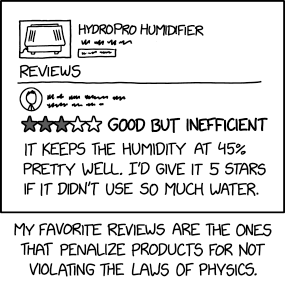
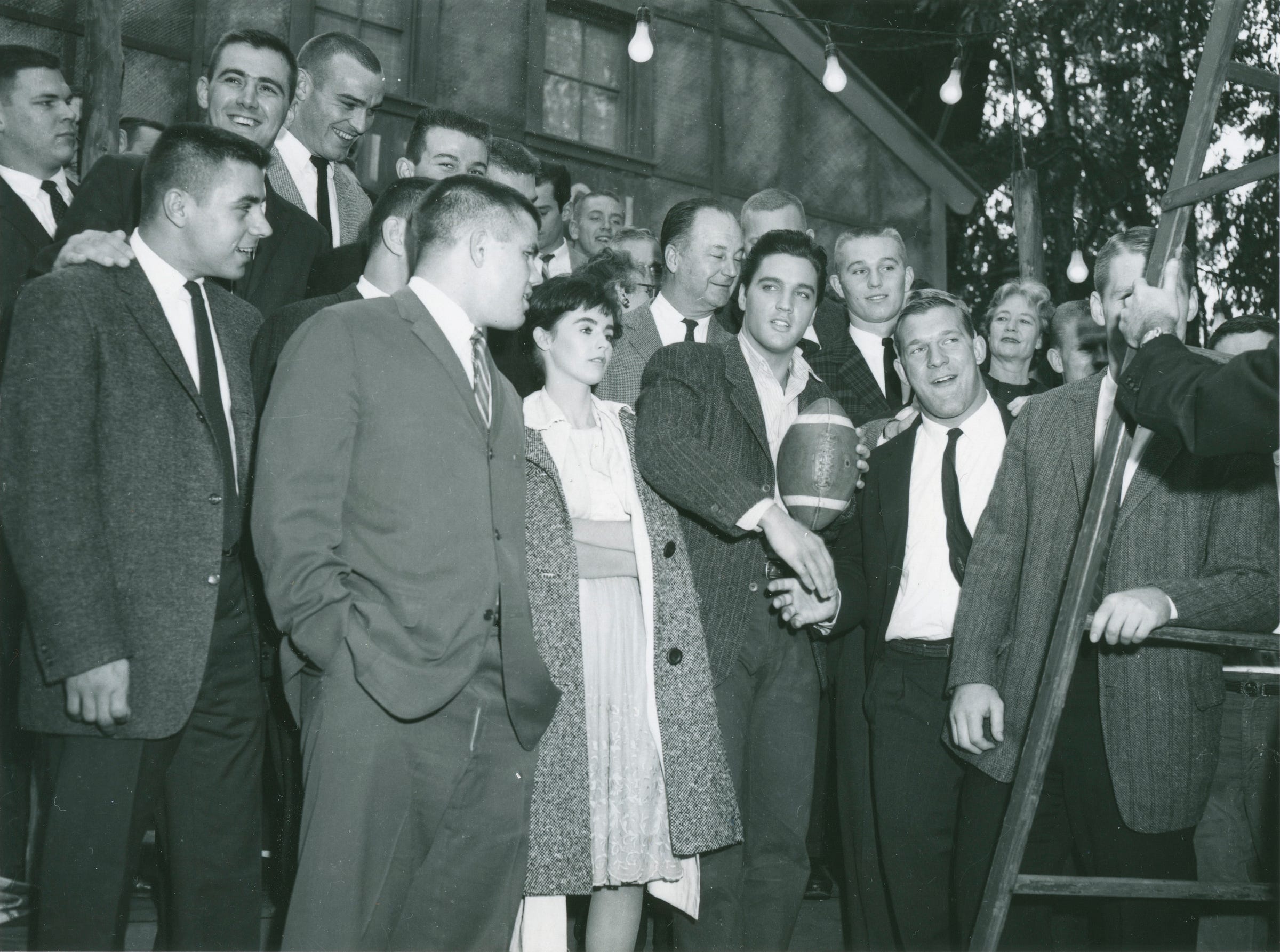
In December of 1960, things were looking up for the Duke University football team. The Blue Devils had gone 4-6 in the year prior, capped off by a 50-0 loss to North Carolina. But by December, Duke was 7-2, and ranked 11th in the polls. They were on a roll by the time they flew to California for a big game against UCLA.
And then they met Elvis Presley.
Duke’s coach, Bill Murray (not that Bill Murray), brought his team to Los Angeles a day early and arranged for them to have a tour of 20th Century Fox studios. While they were there, they got a chance to watch Elvis shooting some scenes for a new film called “Wild in the Country.” Afterward, they all posed for a picture. It was memorable. Maybe too memorable. “I think we were probably a bit too preoccupied with meeting Elvis and watching the filming,” says Mark Leggett, who was a 19-year-old sophomore running back at the time. “And so we played the game, but we didn't play a good game.” They lost to UCLA the next day, 27-6.
The set was crowded, but somehow, Leggett found himself chatting with one of the most famous celebrities in the world. The conversation lasted about five minutes. About Duke. About football. And about a very memorable trip that Elvis once made to Lexington, North Carolina. Elvis told a joke about it—or what might be a joke—that members of that team, including Leggett, now 83, have never forgotten. It seems that the people in Lexington long remembered Elvis’s one-and-only visit to their small town. Elvis remembered it too. But for a very different reason.
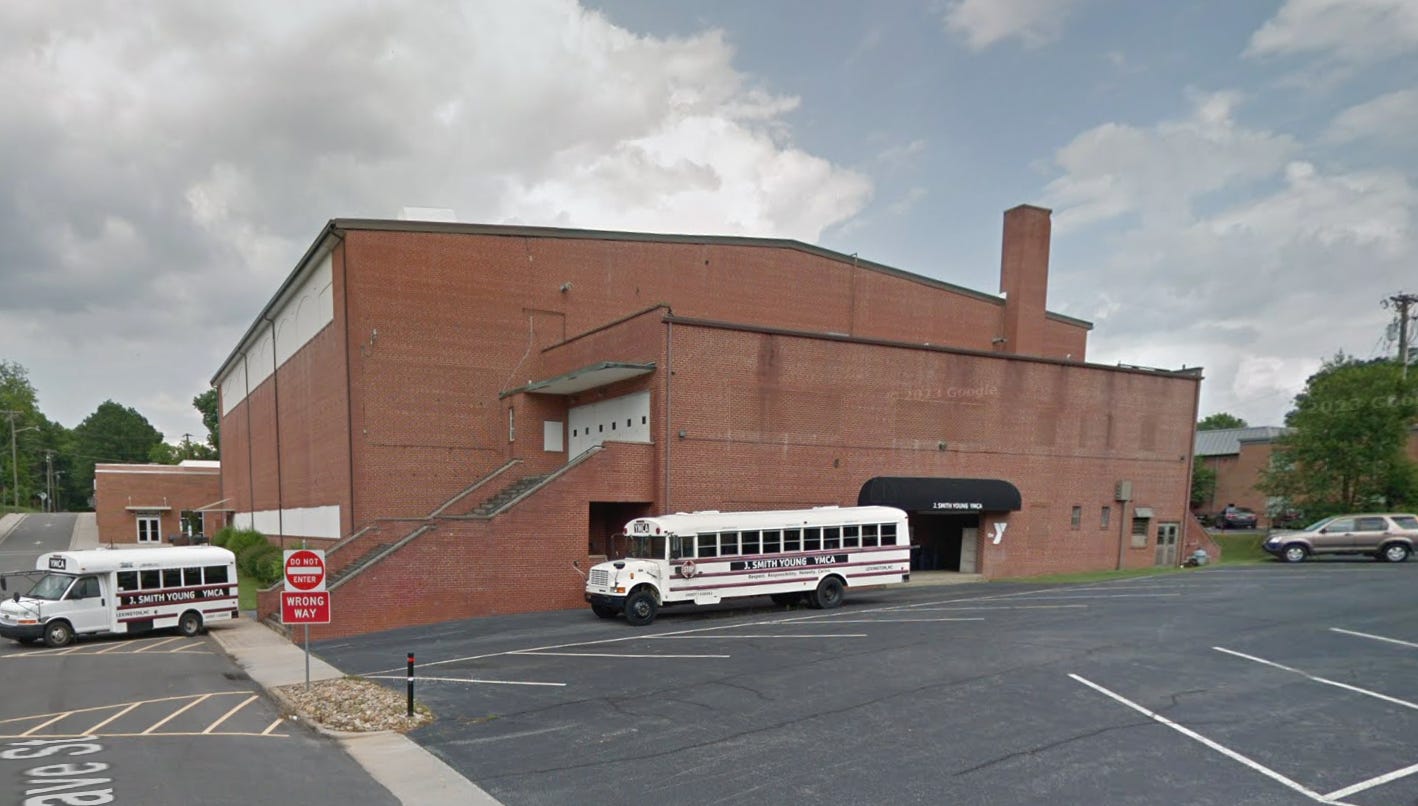
In March of 1956, the folks who ran the Civitan Club in Lexington thought they had a problem on their hands. They were holding their annual fundraiser, and they’d hired country star Eddy Arnold to headline it. But about two weeks before the concert, his manager called to say that Arnold couldn’t make it. The manager, Col. Tom Parker, said there was nothing to worry about. He was sending a replacement. The new singer was 21, a rock and roller, and about to break into the big time. The folks at the Civitan Club had no idea who he was. “I was a little dubious of having him,” L.C. Harpe, the president of the Civitans at the time, later recalled to the Greensboro News & Record. “I had never heard of Elvis Presley.”
Parker gave Harpe an option. He could either take half of the gate, or a flat fee $200. Harpe took the flat fee. He’d later regret it.
Word spread like wildfire. The venue for the show was the new Lexington YMCA, which had a gymnasium that could seat 4,000. It predated coliseums in Winston-Salem and Greensboro, and was the biggest venue in the area, but it had been used mostly for wrestling shows. This was different. Young girls, who knew exactly who Elvis was, snapped up tickets quickly.
Elvis himself rolled into town at 5:30 in the morning on March 21, 1956. He wasn’t feeling well. He and his crew slept for four hours in a room at the New Lexington Hotel on North Main Street. Then they got up to do laundry.
The owner of the cleaning company showed Elvis how to tie a Windsor knot.
By lunchtime, Elvis was still under the weather. A doctor who came to the hotel diagnosed him with a sore throat and a mild case of the flu, and gave him a few prescriptions to help.
At 3:30, Elvis came downstairs and met the daughter of the hotel’s owner, a high school senior in town. She wasn’t planning on going to the show that night, so Elvis gave her three tickets. “I was not overly impressed,” she told the News & Record years later. “And I was not a fan.”
As showtime approached, Elvis was still sick. “I guess I should rest some,” he told reporters in his dressing room, “but my friends are coming out to see me, and the show must go on.” Inside the gym, Elvis’s road crew was building a bigger stage and adding more seats. They’d been on tour, most recently stopping in Winston-Salem and Charlotte, and they knew what was coming. The non-teenage citizens of Lexington had no clue. “The people stormed the ticket booth and we never did stop selling tickets,” a local grocery store owner recalled years later. “What a madhouse it was.”
The local Civitan Club, which wasn’t sure if anyone would show up to see their substitute singer, now had a packed gymnasium full of 5,000 people who’d paid $1 or $1.50 to see Elvis. Some 2,000 people had to be turned away.
First came the opening acts. Mother Maybelle and the Carter Sisters, featuring June Carter. Rod Brasfield. Hal and Ginger. Backstage, Elvis was taking promotional pictures and kissing girls, which had become part of his shtick. The girls loved it. The boys were jealous.
Then Elvis took the stage in a white suit, and a black and pink shirt and tie. “I couldn’t believe what I was seeing. The screaming and crying and all that was going on,” recalled a YMCA board member in a newspaper story two decades later. He’d never experienced rock and roll before. Or a swarm of young girls. “We had to keep the girls back. And if we had known we were going to get that kind of a reaction, we would have charged more for the concert.”
Elvis performed “Blue Suede Shoes,” “I Got A Woman,” and “Heartbreak Hotel.” He swayed his hips. The screams were so loud that it was hard to hear.
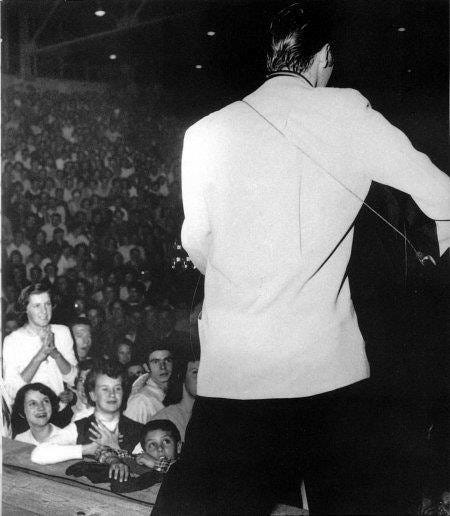
By one account, Elvis played for an an hour. Another said he was only on stage for 15 minutes. Afterward, it took him an hour of pushing and shoving to get him out of the gym. Police whisked him back to the hotel, where he was ushered in through the fire escape to get away from the crowds. It didn’t work. Elvis kept giving out kisses and autographs to the girls who seemed to be everywhere he was.
The hotel owner’s daughter saw Elvis in the lobby. She’d witnessed the mob, and called some teenage friends over to take everything in. Elvis was hungry, so she and her friends took him to a steakhouse south of town, where they woofed down food in a private dining room. He was kind. Polite. He autographed a picture for her (that she later lost). Later in the night, they went to go look at cars at the Lincoln-Mercury dealership owned by her friend’s dad. “Elvis was so car crazy,” she recounted to the News & Record.
Sometime after 2 a.m., the teenagers dropped Elvis back off at the hotel. In the morning, he left to play his next show in Richmond. He never came back.
After that, Elvis Presley became Elvis. He starred in movies. Made an appearance on the Ed Sullivan Show. He joined the Army in 1958. Got out in 1960. Young Elvis morphed into the mutton-chop sideburned, white jumpsuited, Graceland-dwelling, Vegas residency Elvis. He became one of the famous people in the world, and his life was dissected in magazines, newspapers, tabloids, books, biopics, and TV shows. People had a lot to say about everything from his diet to his drug use to his dirty jokes to his generosity and fun-loving side to his sexual proclivities (or lack thereof). By the time he died in 1977, it was nearly impossible not to know something about Elvis.
But in 1956, Elvis was still unknown enough to play a show in Lexington, which only had a population of 13,000ish people. The night became one of the biggest events in the town’s history. It’s still celebrated today with an Elvis-related festival in Lexington that draws in impersonators. His only visit was extremely well-documented, thanks to a wealth of newspapers articles, remembrances, a book, and a feature story from Pageant magazine, which provided this scene:
Not long ago, down in Lexington, N.C., he sought sanctuary from his clamoring fans in the local pool hall. It was restful there, and quiet, under a soiled wall sign that read, "Please, No Loud Profanity." And with only the clicking balls to disturb the serenity of the moment, Elvis bravely faced the future. "I guess I gotta admit them little ol' gals do bug me, sometimes," he said, "but I’m a goin' to go on meetin' my people so long as I got the strength. 'Cause, as I see it, you’re only in business as long as they're aggravatin’ you." He chalked his cue, then grinned like a tall ol' possum. "Know what a real purty one said to me last night?" he asked. “She said, 'Jes’ touch me, honey, an` I’ll frame the spot in gold.' Man, this is livin.' "
At which point Cousin Gene, who had the nine-ball lined up for the corner pocket, flubbed his shot.
Mark Leggett didn’t know about the Lexington show before he met Elvis in 1960. He forgot to ask him for an autograph. But their conversation stuck with him for more than sixty years. It became the stuff of legend among his teammates.
“He asked who we were, and I told him we were the Duke football team we were out to play UCLA,” Leggett says. “I said if you're interested in the game, I'll leave a ticket for you. He chuckled and said ‘Oh heavens no, if I came to the game, nobody would be interested in watching you folks. They’d be interested in me!’”
“It’s so true,” Leggett says, with the benefit of 64 years of hindsight.
Then Elvis asked Mark where Duke University was located. Durham, North Carolina, Leggett told him. “I’m familiar with North Carolina” Elvis shot back. “I caught the clap in Lexington.”
Tragically, Los Angeles resident Brandon Sanders found his home had burned to the ground in the Eaton fire.

There was one good piece of news: His Tacoma had been parked far enough away from the burning structure that only the front of the vehicle was scorched. To his surprise, when he tried to start it "it fired right up," he writes. "Everything works, even the headlights and blinkers!"
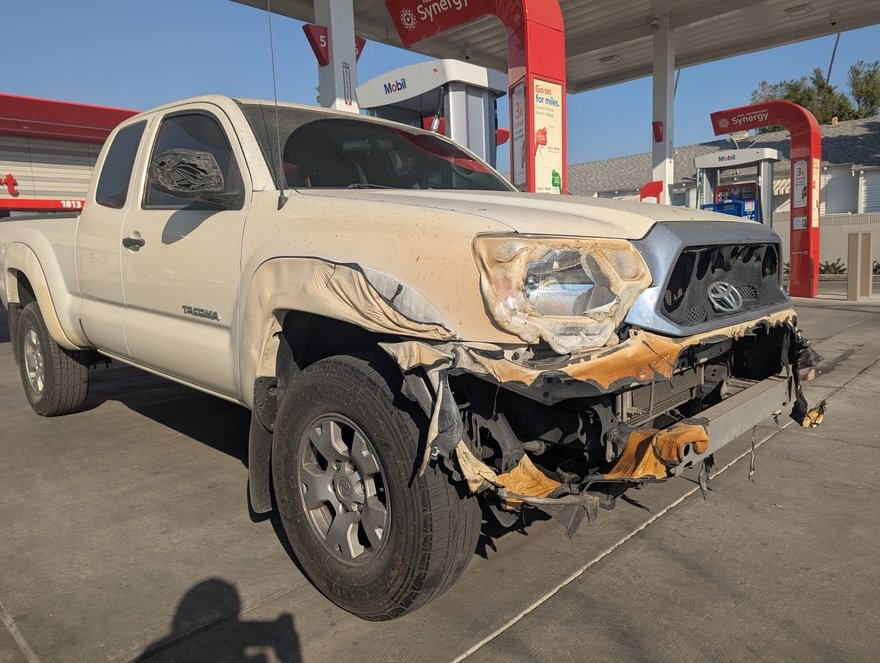


Social media being social media, there are now posts going around claiming that Tacomas are fireproof. It should be obvious to the sane, but Sanders' experience with the truck was very good luck. In this other photo, here we see a house that was unscathed by the fire:

Note the unlucky SUV on the neighboring property that burned. Beneath it, you can see that aluminum has melted beneath the vehicle and flowed down the driveway. Aluminum melts at 1,221° Fahrenheit (660° Celsius). The Tacoma was not exposed to that temperature, or it would look like this SUV.

The unburned house, by the way, was designed by architect Greg Chasen. "Some of the design choices we made here helped," he writes. "But we were also very lucky."
If you're interested in what design decisions can harden a house against fire, in this comprehensive video—which has gone viral—homebuilder Matt Risinger analyzes two unburnt L.A. homes. One is the Chasen-designed house, and the other belongs to Tom Hanks:


A fire broke out at the Moss Landing Energy Storage Facility in Central California Thursday. The battery power plant is the largest in the world according to the company, Vistra, that owns it.
The Monterey County Sheriff’s Office issued evacuation orders for nearby residents and closed parts of Highway 1 in response. County Health officials have asked other residents to shelter indoors with windows and doors closed and to switch off ventilation systems.
“There’s no way to sugarcoat it. This is a disaster, is what it is,” Monterey County Supervisor Glen Church told KSBW-TV.
The company will investigate the cause of the fire once it’s out, Vistra spokesperson Jenny Lyon told The Mercury News. Vistra did not immediately respond to an email from The Verge. It completed an expansion of the facility in 2023, adding more than 110,000 battery modules needed to store renewable energy. Energy storage facilities like this one are essential for power grids to be able to keep enough excess solar and wind energy so it’s available when the sun goes down and winds wane.
This isn’t the first battery fire in the area. A nearby Pacific Gas & Electric battery plant stocked with Tesla batteries caught fire back in 2022. The year prior, Vistra had to temporarily shut down its battery plant at Moss Landing after a malfunctioning smoke detector and heat-suppression system sprayed water on its batteries, Canary Media reported.
The current blaze is unrelated to fires burning further south that have devastated Los Angeles County.
It's frustrating when useful tools refuse to work together nicely. In the past I've experienced conflicts between black and flake8 that made it impossible to commit via my default commit hooks. Now I'm seeing the same behaviour with black and reorder-python-imports.
In short, almost a year ago now github user maxwell-k reported that black release 24.1.0 had introduced an incompatibility with reorder-python-imports by starting to require a blank line after a module docstring. In the discussion on the bug report the black crew make the reasonable-seeming point that it's black's job to determine the disposition of whitespace, and that reorder-python-imports should do what its name implies and nothing more. This would respect the long-standing Unix tradition that each tool should as far as possible perform a single function.
Unfortunately, when elagil raised the same issue with the reorder-python-imports developers, with a request to make their project usable with black (ably supported by maxwell-k), they received a response which I can only (avoiding the use of expletives) describe as disappointing:
anything is possible. will it happen here: no
In my opinion this uncompromising attitude displays the worst kind of arrogance from a developer, and I frankly fail to see who benefits from this refusal to bend (except perhaps a developer unwilling to work further on a project or set it free). The net consequence from my own point of view is that I'll no longer be using reorder-python-imports, nor recommending it.
The situation remains unchanged. Life's too short to persuade donkeys to move. On the plus side, research into solving this irritation led me to start working with ruff, which provides the functionality of both utilities in a single rather faster tool. It's an ill wind that blows nobody any good. Goodbye, donkeys!
https://web.archive.org/web/20151231221001/http://bl0ckeduser.github.io/sleepsort/sleep_sort_trimmed.html


